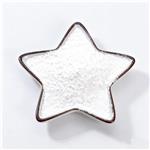Methylene blue is a heterocyclic aromatic chemical compound with the molecular formula C16H18N3SCl. It has many uses in a range of different fields, such as biology and chemistry. At room temperature it appears as a solid, odorless, dark green powder, that yields a blue solution when dissolved in water. The hydrated form has 3 molecules of water per molecule of methylene blue. Methylene blue should not be confused with methyl blue, another histology stain, new methylene blue, nor with the methyl violets often used as pH indicators.
Methylene Blue, 1% w/v aqueous solution is used as a dye in different staining procedures viz. Wright's stain and Jenner's stain. It also serves as an indicator and medicine. Further, it is used to examine RNA and DNA under the microscope or in a gel. It is widely used as a redox indicator in analytical chemistry. It is also used in the sulfide analysis.
A useful inhibitor of cGMP-mediated processes and a useful stain
ChEBI: An organic chloride salt having 3,7-bis(dimethylamino)phenothiazin-5-ium as the counterion. A commonly used dye that also exhibits antioxidant, antimalarial, antidepressant and cardioprotective properties.
MethyleneBlue45,C.I. 52 015 [61-73-4], is obtained by oxidation of 4-aminodimethylaniline in the presence ofsodium thiosulfate to give the quinonediiminothiosulfonic acid, reaction with dimethylaniline, oxidation to the indamine, and cyclization to give the thiazine.
Methylene blue, also known as methylthioninium chloride, is a photoactive phenothiazine dye. It is a small molecular weight dye, which is effective against Gram positive and Gram negative bacteria.
Biological stain and redox indicator. Inhibits tau filament formation (IC 50 = 1.9 μ M). Also inhibits soluble guanylyl cyclase.
Methylene blue (MB) is a highly recognized histological dye. It plays a vital role in microbiology and pharmacology. It has been employed in staining living organisms and in methemoglobinemia treatment. MB exhibits maximum absorption at 664nm. Exposure to methylene blue leads to various health hazards such as increased heart rate, vomiting, shock, Heinz body formation, cyanosis, jaundice, quadriplegia and tissue necrosis in humans
Methylene blue is 3,7-bis(dimethylamino)-phenazathioniumchloride (Urised). The compound occurs as a dark greencrystalline powder with a metallic appearance that is solublein water (1:25) and alcohol (1:65).
Methylene blue has weak antiseptic properties that makeit useful for the treatment of cystitis and urethritis. The actionof methylene blue is considered to be bacteriostatic.The compound colors the urine and stool blue green.
Poison by ingestion,intraperitoneal, intravenous, and subcutaneous routes.Human systemic effects: cyanosis, blood changes.Experimental reproductive effects. Mutation datareported. When heated to decomposition it emits verytoxic fumes of NOx, SOx, and
Veterinary Drugs and Treatments
Methylene blue is used primarily for treating methemoglobinemia
secondary to oxidative agents (nitrates, chlorates) in ruminants. It
is also employed occasionally as adjunctive or alternative
therapy
for cyanide toxicity.
Intra-operative methylene blue is also being used to preferentially
stain islet-cell tumors of the pancreas
in dogs in order to aid in
their surgical removal or in determining the animal’s prognosis.
Crystallise the chloride from 0.1M 664 2HCl (16mL/g), the crystals are separated by centrifugation, washed with chilled EtOH and diethyl ether, and dried under vacuum. Crystallise it from 50% aqueous EtOH, wash it with absolute EtOH, and dry it at 50-55o for 24hours. It has also been crystallised from *benzene/MeOH (3:1). It has been salted out with NaCl from a commercial concentrated aqueous solution, then crystallised from water, and dried at 100o in an oven for 8-10hours. [Beilstein 27 III/IV 5152.]



